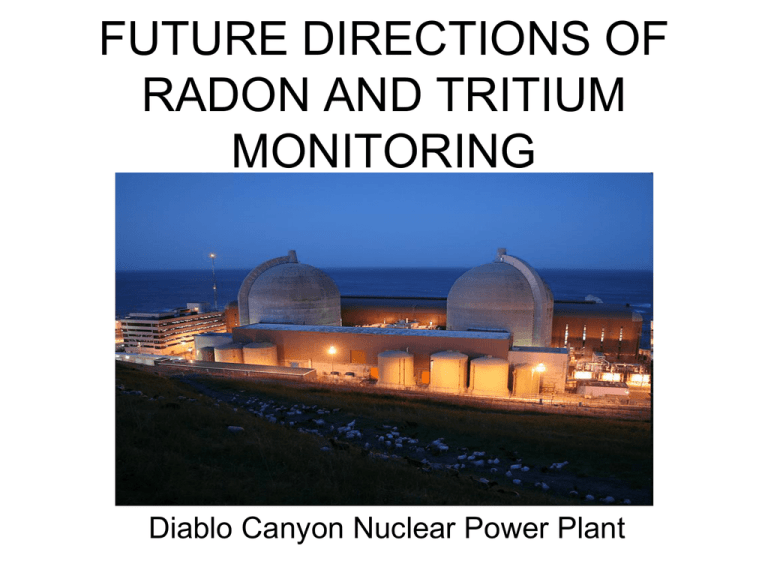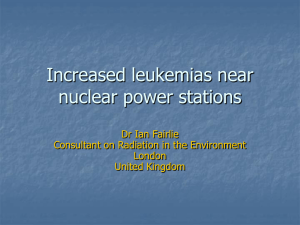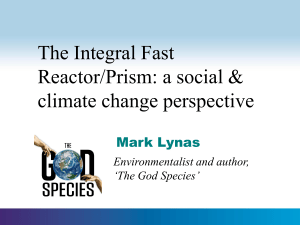future directions
advertisement

FUTURE DIRECTIONS OF RADON AND TRITIUM MONITORING Diablo Canyon Nuclear Power Plant James T. (Tom) Voss, NRRPT, CHP Fellow of the Health Physics Society PO Box 1362 Los Alamos, NM 87544 jtvoss@newmexico.com 505-920-1470 WWW.VOSS-ASSOCIATES.COM What are the Current Applications for Radon and Tritium Monitoring • • • • Current Nuclear Power Reactors Current Research and Test Reactors New Nuclear Power Reactors Small Transportable Nuclear Reactors What are the Current Applications for Radon and Tritium Monitoring • International Thermonuclear Experimental Reactor (ITER) • DOE Operations • Medical • Resurgence in Uranium Mining What are the Current Applications for Radon and Tritium Monitoring • • • • Uranium Fuel Fabrication Thorium as a Reactor Fuel Nuclear Fuel Reprocessing Need for Remote Real-time Monitoring of Nuclear Facilities Current Nuclear Power Reactors Current Research and Test Reactors New Nuclear Power Reactors Applications for License Renewal Calvert Cliffs, Units 1 and 2 Oconee Nuclear Station, Units 1, 2 and 3 Arkansas Nuclear One, Unit 1 Edwin I. Hatch Nuclear Plant, Units 1 and 2 Turkey Point Nuclear Plant, Units 3 and 4 North Anna, Units 1 and 2, and Surry, Units 1 and 2 Peach Bottom, Units 2 and 3 St. Lucie, Units 1 and 2 Fort Calhoun Station, Unit 1 McGuire, Units 1 and 2, and Catawba, Units 1 and 2 H.B. Robinson Nuclear Plant, Unit 2 Applications for License Renewal R.E. Ginna Nuclear Power Plant, Unit 1 V.C. Summer Nuclear Station, Unit 1 Dresden, Units 2 and 3, and Quad Cities, Units 1 & 2 Farley, Units 1 and 2 Arkansas Nuclear One, Unit 2 D.C. Cook, Units 1 and 2 Millstone, Units 2 and 3 Point Beach, Units 1 and 2 Browns Ferry, Units 1, 2, and 3 Brunswick, Units 1 and 2 Nine Mile Point, Units 1 and 2 Applications for License Renewal Monticello Palisades James A. FitzPatrick Wolf Creek, Unit 1 Harris, Unit 1 Oyster Creek Vogtle, Units 1 and 2 Three Mile Island, Unit 1 Beaver Valley, Units 1 and 2 Susquehanna, Units 1 and 2 59 APPLICATIONS FOR LICENSE RENEWAL HAVE BEEN ACCEPTED Applications Currently Under Review Pilgrim 1, Unit 1 Vermont Yankee Indian Point, Units 2 and 3 Prairie Island, Units 1 and 2 Kewaunee Power Station Cooper Nuclear Station Duane Arnold Energy Center Applications Currently Under Review Palo Verde, Units 1, 2, and 3 Crystal River, Unit 3 Hope Creek Salem, Units 1 and 2 Diablo Canyon, Units 1 and 2 Columbia Generating Station 19 APPLICATIONS FOR LICENSE RENEWAL ARE UNDER REVIEW Radon and Tritium Monitoring in Nuclear Reactor Facilities Radon monitoring is performed to; • alert personnel to the potential for personal contamination due to radon • alert personnel to the potential for degradation in the performance of alpha CAMs • alert personnel to unacceptably high levels of radon in the facility Radon and Tritium Monitoring in Nuclear Reactor Facilities Tritium monitoring is performed to; • alert personnel to the potential for inhalation of tritium • alert personnel to the potential malfunction of plant liquid process equipment Radon and Tritium Monitoring Outside Nuclear Reactor Facilities Radon monitoring is performed to establish environmental background levels of alpha and beta emitters in the ambient air. Radon and Tritium Monitoring Outside Nuclear Reactor Facilities Tritium monitoring is performed to; • establish a baseline level of tritium in the ambient air and water outside the facility boundary • alert personnel to the potential malfunction of plant liquid process equipment Special Applications for Tritium Monitors Inside Nuclear Reactor Facilities Simultaneous and separate monitoring of elemental tritium and tritium oxide can be used to identify the presence of leaks in the hydrogen recombiner in the facility. Elemental tritium will only exist for a short period of time before it either combines with an oxygen atom or it replaces a hydrogen atom on a water molecule. Special Applications For Tritium Monitors For The ITER Project ITER will require a lot of tritium to start. This leads to the need for tritium monitors inside the facility, around its perimeter, and at those locations producing tritium for ITER. Tritium monitors with high working ranges will be needed for ITER in addition to conventional tritium monitors ITER is scheduled to start producing power in 2018. Special Applications For Tritium Monitors For DOE DOE is continuing with refurbishing the US nuclear arsenal. The tritium in those devices must be replaced about every 15 years. The gamma radiation from the device drives the need for tritium monitors with active gamma compensation. Special Applications For Tritium Monitors For DOE DOE produces and maintains a supply of elemental tritium for our weapons program. Since the elemental tritium combines with oxygen readily there is a need to simultaneously monitor for elemental tritium and tritium oxide. The presence of elemental tritium outside its containment indicates that tritium is leaking from its containment. Small Transportable Nuclear Power Reactors Small Transportable Nuclear Power Reactors What is in the future for these power reactors ? It seem unlikely the NRC will grant operating licenses for these types of nuclear power reactors. It seems unlikely the final cost for these types of nuclear power reactors could equal that of the new commercial nuclear power reactors. Resurgence in Uranium Mining Resurgence in Uranium Mining The EPA estimates there will be 10,000 to 15,000 more uranium miners in the US by 2015. The EPA is considering lowering the allowable radon exposures for uranium miners. World Uranium Production Tons of Uranium 2007 2008 Canada 9476 9000 Kazakhstan 6637 8521 Australia 8611 8430 Namibia 2879 4366 Russia 3413 3521 Niger 3153 3032 Uzbekistan 2320 2338 USA 1654 1430 World total 41,282 43,853 United States Uranium Production Tons of Uranium USA 2007 1654 2008 1430 World total 41,282 43,853 US Uranium Current Production is Primarily From 4 Mines. 90% of US Uranium Mining is In-Situ. Uranium Mines in Canada Uranium Mines in Australia Worker, Public, and Environmental Protection for Uranium Mining • Controlled Ventilation • Radon and Airborne Uranium Monitoring • Portable and Personal Continuous Air Monitors • In-Situ Mining • Open Pit Mining Worker Protection for Uranium Mining Radon and Airborne Uranium Monitoring • Routine area radon and uranium monitoring with sophisticated instruments • Radon monitoring before opening a new area to workers • Personal radon and uranium monitors for workers Public and Environmental Protection for Uranium Mining There is a need for a CAM for Continuously Monitoring for Airborne Alpha and Beta Activity at High Volumetric Sampling Rates. Public and Environmental Protection for Uranium Mining In-Situ Mining In-Situ mining leaches the uranium ore from the underground deposit and greatly reduces the volume of above ground waste. Public and Environmental Protection for Uranium Mining Open Pit Mining • Reduces the risk to the workers by providing better ventilation and reduces other risks in underground mining • Exposes more rock dust and uranium ore that could increase the spread of those into the environment • Australia’s Olympic Dam mine is converting to an open pit operation Public and Environmental Protection for Uranium Mining Closing and covering an open pit mine at the end of its useful life could provide the best permanent solution for protecting the public and the environment. In-Situ mining could also minimize the mine’s affect on the public and the environment. Uranium Fuel Cycle Facilities Uranium Fuel Cycle Facilities Uranium Hexafluoride Production Honeywell International, Inc. Metropolis, IL Uranium Fuel Cycle Facilities Gas Centrifuge Uranium Enrichment Areva Enrichment Services (under review) Idaho Falls, ID Louisiana Energy Services (in construction) Eunice, NM U.S. Enrichment Corporation (in construction) Piketon, OH Uranium Fuel Cycle Facilities Gaseous Diffusion Uranium Enrichment U.S. Enrichment Corporation Paducah, KY U.S. Enrichment Corporation Piketon, OH (cold standby) Uranium Fuel Cycle Facilities Laser Separation Uranium Enrichment GE-Hitachi Wilmington, NC (under review) Uranium Fuel Cycle Facilities Uranium Fuel Fabrication AREVA NP, Inc. Lynchburg, VA AREVA NP, Inc. Richland, WA B&W Nuclear Operations Group Lynchburg, VA Global Nuclear Fuel-Americas, LLC Wilmington, NC Nuclear Fuel Services Erwin, TN (license renewal application submitted) Westinghouse Electric Company, LLC Columbia, SC Uranium Fuel Cycle Facilities Mixed-Oxide Fuel Fabrication Shaw AREVA MOX Services , LLC Aiken, SC (in construction/under licensing review) Uranium Fuel Cycle Facilities • Better Ventilation • Radiation Monitoring • Airborne Radioactivity Monitoring • Criticality Monitoring Uranium Fuel Cycle Facilities These Facilities need Radon and Airborne Radioactivity Monitoring. Due to the presence of gamma radiation from the uranium the radon monitors need active gamma compensation. Nuclear Fuel Reprocessing • Better Ventilation • Radiation Monitoring • Airborne Radioactivity Monitoring • Criticality Monitoring Nuclear Fuel Reprocessing The present US political position is to NOT reprocess nuclear fuel. A small amount of plutonium and uranium are being used to produce MOX (mixed oxide fuel) but the output is small compared to the need. Thorium as a Nuclear Fuel World Supplies in Tons Australia India United States Norway Canada South Africa Brazil Malaysia Other Countries World Total 340,000 300,000 300,000 180,000 100,000 39,000 18,000 4,500 100,000 1,400,000 Benefits of Thorium as a Nuclear Fuel • Greater Abundance than Uranium • Production of Thorium Fuel Does Not Require Isotopic Separation • Use of Thorium Fuel Produces Much Less Long-Lived Transuranics Than Uranium Fuel Thorium Fueled Nuclear Power Reactors Thorium reactors have been used for more than 40 years. Shippingport Atomic Power Station commenced producing electrical power from its thorium-232, uranium-233 powered reactor in 1957 and was decommissioned in 1982. Thorium Fueled Nuclear Power Reactors These nuclear power reactors will have the same radon and tritium monitoring needs as other nuclear power reactors do. Need For Remote Real-Time Radiological Monitoring of Nuclear Facilities • Notification of an Unplanned Release • Identification and Quantification of Unplanned Releases • Tracking of Unplanned Releases to the Environment • Prediction of the Path of Unplanned Releases Radon Potential Map of the US Surface Uranium Deposits Surface Thorium Deposits Some Unplanned Releases from Nuclear Facilities Three Mile Island - 1979 Contributing Factors • Facility Design • Equipment Malfunction • Operator Training Some Unplanned Releases from Nuclear Facilities Chernobyl - 1986 Contributing Factors • Facility Design • Equipment Malfunction • Operator Training Some Unplanned Releases from Nuclear Facilities Japan, Tokaimura - 1999 Contributing Factors • Facility Design • Operator Training Some Unplanned Releases from Nuclear Facilities Practices to Prevent and/or Mitigate the Consequences • Better Facility Designs • Better Equipment Designs • Better Operator Training • Better Radiological Monitoring Inside and Outside the Facilities Summary Portable, Stationary, High Sampling Rate, and Energy Compensated Radon Monitors are needed. Portable, Stationary, Elemental vs. Oxide, and Energy Compensated Tritium in Air Monitors are needed. Stationary Tritium in Water Monitors are needed. References American Nuclear Society www.ans.org Health Physics Society www.hps.org Institute of Nuclear Power Operations www.inpo.info Nuclear Energy Institute www.nei.org US Department Of Energy www.doe.gov US Nuclear Regulatory Commission www.nrc.org







![The Politics of Protest [week 3]](http://s2.studylib.net/store/data/005229111_1-9491ac8e8d24cc184a2c9020ba192c97-300x300.png)
